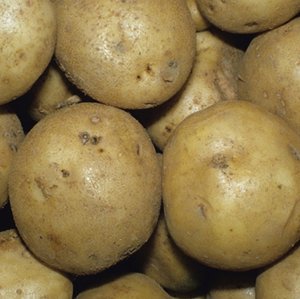Updated: March 14, 2020
Heirloom seed potatoes (a.k.a. heritage seed potatoes) are becoming much more popular. This might be because a lot of people have seen that heirloom tomatoes and apples are often so much better than what is typically offered in the grocery store.
Heirloom potatoes often taste better or are better suited for they type of preparation you are going to use.
But it’s not really the same type of thing as heirloom tomatoes.
Heirloom tomatoes are open pollinated. So that means it’s possible for the genetics of an heirloom tomato seeds to change (unlikely) through the generations when two different tomato plants are their parents.
Heritage seed potatoes, on the other hand, are exact genetic clones of their parents. So they should always taste pretty much the same.
Table of Contents
This is a long, detailed article. You can jump to where you want to be by clicking on the different sections below. To come back to this table of contents, just use the back button on your browser.
Not all potatoes come from seed potatoes
While the vast majority of potato growers grow their plants from seed potatoes, there are some that grow their potatoes from seeds.
Some of these growers do so because they want to use hybrid seeds. The resulting potatoes would definitely not have a long history and not be heirlooms.
What are heirloom seed potatoes?
What would make one potato an heirloom and not another. The answer has to do with how long a plant has been around and, truth be told, how famous it is.
An heirloom potato is any potato that:
- Has a long history
- Is well known among potato growers
- Isn’t originally from a hybrid plant
Let’s take a sec to get the legal words out of the way. This article may contain affiliate links. That means if you click and buy from my partners, I will make a tiny amount of money. This in no way affects my recommendations.
Sometimes people incorrectly refer to newly developed potatoes as heirlooms because they have special characteristics.
Take, for example, the Purple Majesty. Some who sell seed potatoes refer to this very purple potato as an heirloom, or at least group it with true heirlooms. But Purple Majesty was developed in 1994 and hasn’t been around long enough for you to consider it an heirloom.
Baking, boiling or general purpose
Now that we know what characterizes an heirloom potato, let’s talk about general characteristics that are common to all potatoes.
Individual potato types differ in the proportion of starch and sugars. A potato with high starch will make a lighter, less brown chip. On the other hand, a chip made from a potato high in sugar will turn browner when fried.

High starch potatoes, a.k.a. baking potatoes, are ideal for baking, mashing and French fries. They are light and fluffy when baked, light and creamy when mashed, and they are excellent for French fries.
The opposite of a high starch potato is a boiling potato. These tend to have more moisture and sugars.
Boiling potatoes are ideal for soups, casseroles, potato salads, roasting and barbecuing. Some people still mash them, but they tend to end up thick and lumpy.
As you might expect, there are some potatoes that fall in the middle. These general purpose potatoes have a balance of starch and sugar. You can use these for both recipe types.
Indeterminate versus determinate potatoes
One more criteria to measure is how it grows. By this I mean is it (1) determinate or (2) indeterminate. Like tomatoes, potatoes can be classified as either of these.
Most potato varieties are determinate. The plants will only grow to a certain size and will only grow up to a certain amount of potatoes. It also doesn’t make sense to leave them in the ground past their point of full maturity because they won’t set any more potatoes.
Other potato varieties are indeterminate. This means the plants will continue to grow and set potatoes as long as there is time and there is more growing medium (usually dirt). Potato growers typically leave indeterminate varieties in the ground longer and mound them because they will receive a bigger yield if they do.
Heritage seed potatoes
Now that we are clear on the basic potato characteristics, here are three general purpose heirloom seed potatoes that many people enjoy growing in their backyard:
1. Irish Cobbler – A general purpose, determinate potato with moderately high starch content, white skin and white flesh.
It was first reported in 1876, making it a longstanding, popular heirloom variety that people serve mashed. Backyard gardeners like it because of it takes only 95 days to mature, and it’s tasty. Some people don’t like it because, compared to other varieties, it has deep eyes that need to be removed from the flesh.
By the way, you should not confuse “Irish Cobbler” with “Irish potato,” which is a term sometimes used by people that grow both sweet potatoes and regular potatoes. “Irish potato” is used to differentiate regular potatoes from sweet potatoes. Not all Irish potatoes are Irish Cobblers, but all Irish Cobblers are Irish potatoes. Get my drift?
2. German Butterball – GB is an indeterminate variety with a russet skin, yellow flesh and a long storage life. Many claim it as their all-time favorite potato. It took first place in the Rodale Organic Gardening “Taste Off” and, like Irish Cobbler, it’s a general purpose potato that’s great roasted, fried or mashed.
3. Red Pontiac – A determinate variety with thin red skin, white flesh and shallow eyes. RP is very good for mashing and stores pretty well, which is a plus for those that grow a lot of potatoes.
Related articles you might enjoy:
Suburban Hobby Farmer is a participant in the Amazon Services LLC Associates Program, an affiliate advertising program designed to provide a means for sites to earn advertising fees by advertising and linking to amazon.com.